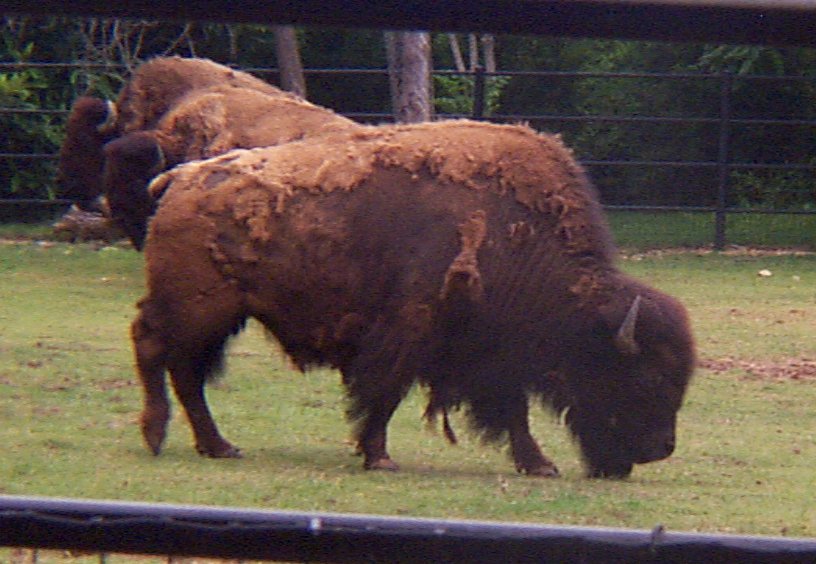 |
 |
| Name: American Plains Bison, more commonly called buffalo. |
| Scientific name: Bison bison |
| Range: Portions of Texas, Oklahoma, Kansas, Nebraska, Colorado, New Mexico, Wyoming, Montana, North and South Dakota, Idaho, and Canada's three western provinces. Note: There are no bison living free, all are in some type of captivity for protective reasons. |
| Habitat: Grasslands and plains. |
| Status: Endangered |
| Diet in the wild: Grass, small plant growth, small shrubs. |
| Diet in the zoo: Hay and native grasses |
| Location in the zoo: Thundering Plains |
| General information:
There were a vast number of bison living in North America at the time of European discovery, there were an estimated 60 million living in the late 18th Century. With the advance westward of colonists, numbers dwindled and by 1820, there were none left east of the Mississippi River. The age of expansion westward brought the transcontinental railroad and the United States governments desire to hunt and eliminate the animal as a way of killing off the Native American population that stood in their way. All this resulted in there only being six hundred bison living in the United States by 1889. However, with the help of legislation for their protection, there are over 200,000 living today on private ranches, parks and reserves. The largest single herd is 3,600 that roam freely in Yellowstone National Park, but that number is threatened because of severe actions taken by the state government of Montana and a severe winter. Bison are in the bovid family and are not true buffaloes. They have fourteen pairs of ribs as opposed to the thirteen that are found in true buffalo. A young bison can mate as early as three years of age but will not become full grown for another five years. In some cases a bison may live to be thirty to forty years old. It has been discovered that any attempt to train a bison has failed because they have quick tempers and are such a massive size. |
| Special anatomical, physiological or behavioral adaptations:
Bison will congregate in small family groups that will form a large herd with other family groups. A close relative is the Wood Bison that has dwindled in numbers. It is larger with a longer neck and hair on its forehead, hairy horns, a darker coloring and a square hump. Plains bison also differ from Wood Bison in that they have "chops" or large clumps of hair on the back of their front legs. |
| Personal Observations:
The American Bison can be used to symbolize the American West. In the 19th Century, the american government tried to destroy it as a way to element the Native Americans and to make way for expansion. The Bison is a majestic creature that epitomizes the simplicity of nature and all of its beauty, but that beauty was almost destroyed because of man's greed for land and careless disregard for the environment. It is only because Bison were at the brink of extinction and someone decided to do something about it that we are able to observe this amazing animal today. |
| Source Materials and Related Links:
Burton, John A. The Atlas of Endangered Species 2nd Ed. pp. 70 & 91. MacMillan Library Reference USA. New York, 1999. The World Book Encyclopedia. vol. 2 pp. 684-685. World Book, Inc. Chicago, 1991. http://www.nbabison.org/ National Bison Association, 1997. March 9, 1999. 1:35 PM. |
| Page author: |
WhoZoo Home Animal Index |